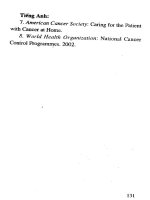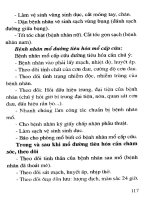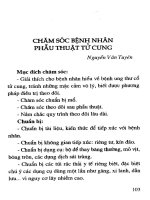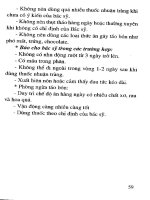Lựa chọn thuốc điều trị ban đầu cho bệnh nhân COPD final
Bạn đang xem bản rút gọn của tài liệu. Xem và tải ngay bản đầy đủ của tài liệu tại đây (13.02 MB, 48 trang )
Lựa chọn thuốc khởi trị cho bệnh
nhân COPD
• ThS. BS. Nguyễn Như Vinh
• Trưởng khoa Thăm Dò Chức năng Hô Hấp – BV.
ĐHYD Tp. HCM
• Trung tâm đào tạo BS Gia Đình– Đại học Y dược Tp.
Hồ Chí Minh
Hải phòng 25/10/2019
Nội dung trình bày
1. Các cách tiếp cận điều trị COPD hiện nay
2. Hạn chế của mỗi cách tiếp cận và những cải
tiến sau các bản cập nhật
3. Lựa chọn điều trị thuốc ban đầu (và sau đó)
theo GOLD 2019 và một số guidelines khác
Tuổi
Giới
Viêm tại phổi
Phơi nhiễm
Cai thuốc lá
Viêm toàn thân
Dinh dưỡng
HO
COPD
Tăng tiết nhầy
Triệu chứng (khó
thở) Dị ứng/Hen
Tăng đáp ứng đường thở
Tuân thủ điều trị
↓CNH
H
(FEV1)
Test GPQ
KHÓ THỞ
TLCO
Căng phồng phổi
BMI
M
ĐÀ
Khí phế thũng
Loạn dưỡng cơ
C
VPQ mạn
Ạ
KH
Dày thành đường thở
Bệnh đồng mắc
Suy mòn (Fraitly)
Đợt cấp
Giảm PaO2
Gắng sức
Nhập viện
Các yếu tố liên quan đến COPD
Tuổi
Giới
Phơi nhiễm
Viêm tại phổi
Cai thuốc lá
Viêm toàn thân
Ạ
KH
Quản
lý COPD
Dày thành
đường
thở dựa vào:
Dinh dưỡng
Loạn dưỡng cơ
BMI
C
M
ĐÀ
HO
1. Các biến số độc lập = GOLD
VPQ mạn
Khí phế thũng
↓CNH
COPD
2. Các bộ chỉ số gộp:
BODE, DOSE, CPI, ADO…
H
Tăng tiết nhầy
3. Các đặc điểm nhận dạng chung và có đáp
ứng
(FEV1)
Test GPQ
KHÓ THỞ
TLCO
điều trị đặc biệt = phenotype
Mức khó
Căng phồng phổi
thở
Dị ứng/Hen
Đợt cấp
Giảm PaO2
Tăng đáp ứng đường thở
Tuân thủ điều trị
Suy mòn (Fraitly)
Bệnh đồng mắc
Gắng sức
Nhập viện
Các yếu tố liên quan đến COPD
Tuổi
Giới
Viêm tại phổi
Phơi nhiễm
(thuốc lá)
Cai thuốc lá
Dinh dưỡng
Viêm toàn thân
HO
COPD
Tăng tiết nhầy
TLCO
Căng phồng phổi
BMI
M
ĐÀ
Khí phế thũng
Loạn dưỡng cơ
C
VPQ mạn
Ạ
KH
Dày thành đường thở
Test GPQ
KHÓ THỞ
Triệu chứng (khó
thở)
↓CNH
H
(FEV1)
Suy mòn (Fraitly)
Đợt cấp
Dị
ứng/Hen
Giảm PaO2 Gắng sức
Tăng đáp ứng đường thở
Bệnh đồng mắc
Nhập viện
Tuân thủ điều trị
Các yếu tố liên quan đến COPD
GOLD 19982010
FEV1
FEV1 một mình không đủ!
1. FEV1 không tương quan tốt với triệu chứng
2. FEV1 không đủ để tiên lượng: không phải tất cả bệnh nhân
COPD có FEV1 sụt giảm nhanh (hơn bình thường) theo thời gian
3. FEV1 không phản ánh chính xác gánh nặng bệnh tật và liên quan
kém với các kết cục lâm sàng có lợi cho bệnh nhân như khả năng
gắng sức, mức độ khó thở hay tình trạng sức khoẻ
4. Điều trị COPD chỉ dựa vào FEV1 không đem lại hiệu quả như
mong đợi.
1. Vestbo, J., Changes in forced expiratory volume in 1 second over time in COPD. N Engl J Med, 2011. 365(13): p. 1184-92.
2. Agusti, A., Characterisation of COPD heterogeneity in the ECLIPSE cohort. Respir Res, 2010. 11: p. 122.
3. Glaab, T., Outcome measures in chronic obstructive pulmonary disease (COPD): strengths and limitations. Respir Res, 2010. 11: p. 79.
Mô hình tiếp cận điều trị dựa vào tổng hợp 3
biến số độc lập của các tác giả Tây Ban Nha
Tây Ban Nha
2010
• Tiền đề của GOLD 2011
• Bên cạnh FEV1 còn thêm
mức khó thở (MRC) và
tiền sử đợt cấp
• 3 trục đánh giá
• Độ nặng theo trục nặng
nhất
• Điều trị theo màu
Lopez-Campos, J.L., Treatment strategies in chronic obstructive pulmonary
disease: a proposal for standardization]. Arch Bronconeumol, 2010. 46(12): p.
617-20.
FEV1
Triệu chứng
Đợt cấp
GOLD 2011
FEV1
Đợt cấp
Triệu chứng
Bất cập trong
cách xếp loại
ABCD theo GOLD
2011
FEV1
Đợt câp
Nhóm
nguy cơ cao:
• 51.2% chỉ có FEV1<50%
• 38% chỉ có 2 đợt
cấp/năm
• 10.7% có đủ 2 tiêu chuẩn
Korean J Intern Med. 2015 Sep; 30(5): 629–637.
Bất cập trong
cách xếp loại
ABCD theo
GOLD 2011
Nhóm C và D:
• Chủ yếu được xếp loại
nhờ vào FEV1<50%
Eur Respir J 2013; 42: 1391-1401.
GOLD 2011
GOLD 2017
X
Spain & US, n=819
Am J Respir Crit Care Med, 2018. 197(4): p. 463-469.
Japan, n=1,168
International Journal of COPD 2018:13 3901–3907
Central & Eastern Europe (POPE) Cohort
n= 3361
European Respiratory Journal 2017 49: 1602518
Taiwan, n=1,053
International Journal of COPD 2018:13 2949–2959
Central & Eastern Europe (POPE) Cohort
Spain & US, n=819
60-70%
European Respiratory Journal 2017 49: 1602518
Am J Respir Crit Care Med, 2018. 197(4): p.
463-469.
+ x% (Việt Nam)
Taiwan, n=1,053
Japan, n=1,168
6070% C,D A,B
International Journal of COPD 2018:13
3901–3907
International Journal of COPD 2018:13 2949–
2959
Các nghiên cứu trong năm 2018
International Journal of COPD
Dovepress
open access to scientific and medical research
Dovepress
open access to scientific and medical research
O R I G I N A L R ESEA R C H
Open Access Full Text Article
O R I G I N A L R ESEA R C H
Open Access Full Text Article
International J ournal of Chronic Obstructive Pulmonary Disease downloaded from by 116.108.89.127 on 02-Feb-2019
For personal use only.
Journal name: International Journal of COPD
Article Designation: Original Research
Year: 2018
Volume: 13
Running head
verso: Oishi et al Journal of COPD
International
Running head recto: 2017 GOLD COPD group A
DOI: 181938
Characteristics of 2017 GOLD COPD group A:
a multicenter cross-sectional CAP study in Japan
Respiratory parameters predict poor outcome in
COPD patients, category GOLD 2017 B
Keiji Oishi1
Tsunahiko Hirano2
Kazuki Hamada2
Sho Uehara2
Ryo Suetake2
Yoshikazu Yamaji2
Kosuke Ito2
Maki Asami-Noyama2
Nobutaka Edakuni2
Kazuto Matsunaga2
Kristian Brat1
Marek Plutinsky1
Karel Hejduk2
Michal Svoboda2
Patrice Popelkova3
Jaromir Zatloukal4
Eva Volakova4
Miroslava Fecaninova5
Lucie Heribanova6
Vladimir Koblizek7
Department of Medicine and
Clinical Science, Graduate School of
Medicine,Yamaguchi University, Ube,
Yamaguchi, Japan; 2Department of
Respiratory Medicine and Infectious
Disease, Graduate School of
Medicine,Yamaguchi University, Ube,
Yamaguchi, Japan
1
Purpose: The 2017 GOLD ABCD classification shifts patients from groups C–D to A–B. Group
A was the most widely distributed group in several studies. It would be useful to understand the
characteristics for group A patients, but little has been reported concerning these issues.
Patients and methods: This was a multicenter cross-sectional study using the COPD
Assessment in Practice study database from 15 primary or secondary care facilities in Japan.
We investigated the clinical characteristics of group A by stratification according to a mMRC
grade 0 or 1.
Results: In 1,168 COPD patients, group A patients accounted for approximately half of
the patients. Compared with the groups B–D, group A was younger and had a higher proportion of males, higher pulmonary function, and higher proportion of monotherapy with
long-acting muscarinic antagonist or long-acting -agonist. The prevalence of mMRC grade
1 patients was about two-thirds of group A. Compared with the mMRC 0 patients, mMRC
1 patients showed a tendency to have a higher proportion of exacerbations (P 0.054) and
had a significantly lower pulmonary function. Regardless of the mMRC grade, 60% of
group A patients were treated with monotherapy of long-acting muscarinic antagonist or
long-acting -agonist.
Conclusion: Group A patients accounted for approximately half of the patients, and they were
younger, had higher pulmonary function, and had lower pharmacotherapy intensity compared
with groups B–D. By stratifying according to the mMRC grade 0 or 1 in group A patients, there
were differences in the exacerbation risk and airflow limitation.
Keywords: COPD, GOLD, mMRC, exacerbation
Introduction
Correspondence: Keiji Oishi
Department of Medicine and Clinical
Science, Graduate School of Medicine,
Yamaguchi University, 1-1-1 Minamikogushi, Ube, Yamaguchi, 755-8505, Japan
Tel 81 83 622 2248
Fax 81 83 622 2246
COPD, attracting attention for its high prevalence and mortality worldwide, is
characterized by persistent airflow limitation that is usually progressive. 1 The prevalence of COPD in Japan is reported to be 8.6%,2 which is comparable with the global
prevalence.3 There have been recent updates to the GOLD guideline, which is the
most widely used treatment guide.4 One important change is the ABCD assessment
tool, which has been modified to utilize only respiratory symptoms and history of
exacerbations. The revised schema includes the following: group A, patients with
few symptoms and no exacerbations; group B, patients with more symptoms but low
risk of exacerbations; group C, patients with exacerbations but few symptoms; and
group D, patients with symptoms and risk of exacerbation.
Very recently, a few studies have reported comparisons of the 2017 and 2015
GOLD ABCD classification. Compared with the 2015 schema, the 2017 GOLD ABCD
classification significantly shifts patients from groups C and D to groups A and B.5,6
Notably, group A is the most widely distributed group in these studies. Although it
3901
submit your manuscript | www.dovepress.com
International Journal of COPD 2018:13 3901–3907
Dovepress
© 2018Oishi et al. This work ispublishedandlicensedbyDoveMedical PressLimited. Thefull terms of this licenseareavailableat />andincorporatetheCreativeCommons Attribution – NonCommercial (unported, v3.0) License( By accessingthework you
herebyaccept theTerms. Non-commercial uses of thework arepermittedwithout any further permissionfromDoveMedical Press Limited, provided thework is properly attributed. For permission
for commercial useof this work, pleaseseeparagraphs4.2and5of our Terms ( />
/>
1 / 1
Department of Respiratory
Diseases, Faculty of Medicine,
University Hospital Brno, Masaryk
University, Brno, Czech Republic;
2
Faculty of Medicine, Institute of
Biostatistics and Analyses, Masaryk
University, Brno, Czech Republic;
3
Pulmonary Department, University
Hospital, Ostrava, Czech Republic;
4
Pulmonary Department, University
Hospital, Olomouc, Czech Republic;
5
Department of Pneumology, Bulovka
Hospital, Prague, Czech Republic;
6
Department of Respiratory Medicine,
Thomayer Hospital, Prague, Czech
Republic; 7Pulmonary Department,
Faculty of Medicine in Hradec
Kralove, University Hospital
Hradec Kralove, Charles University,
Hradec Kralove, Czech Republic
1
Background: Respiratory parameters are important predictors of prognosis in the COPD
population. Global Initiative for Obstructive Lung Disease (GOLD) 2017 Update resulted in
a vertical shift of patients across COPD categories, with category B being the most populous
and clinically heterogeneous. The aim of our study was to investigate whether respiratory
parameters might be associated with increased all-cause mortality within GOLD category B
patients.
Methods: The data were extracted from the Czech Multicentre Research Database, a prospective, noninterventional multicenter study of COPD patients. Kaplan–Meier survival analyses
were performed at different levels of respiratory parameters (partial pressure of oxygen in
arterial blood [PaO2], partial pressure of arterial carbon dioxide [PaCO2] and greatest decrease
of basal peripheral capillary oxygen saturation during 6-minute walking test [6-MWT]).
Univariate analyses using the Cox proportional hazard model and multivariate analyses
were used to identify risk factors for mortality in hypoxemic and hypercapnic individuals
with COPD.
Results: All-cause mortality in the cohort at 3 years of prospective follow-up reached 18.4%.
Chronic hypoxemia (PaO2 7.3 kPa), hypercapnia (PaCO2 7.0 kPa) and oxygen desaturation during the 6-MWT were predictors of long-term mortality in COPD patients with forced
expiratory volume in 1 second 60% for the overall cohort and for GOLD B category patients.
Univariate analyses confirmed the association among decreased oxemia ( 7.3 kPa), increased
capnemia ( 7.0 kPa), oxygen desaturation during 6-MWT and mortality in the studied groups
of COPD subjects. Multivariate analysis identified PaO2 7.3 kPa as a strong independent risk
factor for mortality.
Conclusion: Survival analyses showed significantly increased all-cause mortality in hypoxemic
and hypercapnic GOLD B subjects. More important, PaO2 7.3 kPa was the strongest risk factor,
especially in category B patients. In contrast, the majority of the tested respiratory parameters
did not show a difference in mortality in the GOLD category D cohort.
Keywords: mortality, hypoxemia, hypercapnia, COPD, GOLD 2017 update
Introduction
Correspondence: Vladimir Koblizek
Pulmonary Department, Faculty of
Medicine in Hradec Kralove, University
Hospital Hradec Kralove, Charles
University, Sokolska 581, 50005 Hradec
Kralove, Czech Republic
Tel 420 495 83 4771
COPD is a major health problem affecting 11.7% of the global population and causing the death of about 3 million persons annually. 1 Currently, the Global Initiative
for Obstructive Lung Disease (GOLD) introduced a new approach in COPD classification by using separate evaluations of spirometric values (stages 1–4) and the
presence of symptoms and exacerbations (categories A–D).1 Application of the new
GOLD 2017 recommendations profoundly affected the distribution of patients in the
A–D groups. An obvious consequence of the new classification is a vertical shift of
a large portion of COPD patients from the C to the A group and from the D to the
1037
submit your manuscript | www.dovepress.com
International Journal of COPD 2018:13 1037–1052
Dovepress
© 2018Brat et al. Thiswork ispublishedandlicensedbyDoveMedical Press Limited. Thefull termsof this licenseareavailableat />andincorporatetheCreativeCommons Attribution– NonCommercial (unported, v3.0) License( By accessingthework you
herebyaccept theTerms. Non-commercial uses of thework arepermittedwithout any further permissionfromDoveMedical Press Limited, providedthework is properly attributed. For permission
for commercial useof thiswork, pleaseseeparagraphs4.2and5of our Terms( />
.S147262
Bệnh nhân nhóm B có nhẹ?
Comparison of the 2017 and 2015 Global Initiative for Chronic
Obstructive Lung Disease Reports. Impact on Grouping and Outcomes
A
C
B
D
KaplanMeier curves for survival
Am J Respir Crit Care Med, 2018. 197(4): p.
GOLD 2017
GOLD 2017
Các biện pháp điều trị
bị đóng khung trong 4
chữ A,B,C,D
GOLD 2011 A-D CHART under the microscope. Responding to
COPD physiopathogeny with implications in disease management
vista Americana de Medicina Respiratoria Vol 17 No 1 - Marzo 2017
Đề xuất điều trị COPD tiền GOLD 2019
Đầu tiên, đặt bệnh nhân vào ô điều trị hiện tại
Sau đó, xem xét:
-Tăng bậc: để trị khó thở (mũi tên 2) hay đợt cấp (mũi
tên 1 và 2)
-Chuyển đổi: nếu chưa đủ hiệu quả (mũi tên 3)
-Giảm bậc: có thể xảy ra ở bất cứ bước nào, nếu đáp
ứng chưa tốt hay bị tác dụng phụ hay nếu sử dụng quá
mức trước đó
Mô hình tiếp cận quản lý COPD theo kiểu hiệu chỉnh điều trị sau khi bệnh nhân
đã được chọn điều trị ban đầu theo xếp loại ABCD của Singh và cộng sự
Eur Respir J, 2018. 51(4).
Đề xuất điều trị COPD tiền GOLD 2019
Mô hình điều trị COPD theo kiểu bậc thang theo đề xuất của Shireen Mirza và cộng sự 10/2018
Mayo Clinic Proceedings, 2018. 93(10): p. 1488-1502.
GOLD 2019
Ưu nhược điểm của GOLD 2019
Ưu điểm
Thoát khỏi khuôn khổ ABCD
nhờ chiến lược điều trị ban
đầu và hiệu chỉnh
Tăng giảm điều trị tuỳ tình
trạng bệnh nhân # điều trị
HEN
Treatable traits: khó thở và
đợt cấp
Mang tính cá thể hoá
Hạn chế
Cách xếp loại ABCD không
thay đổi:
• Mâu thuẫn mMRC vs. CAT
(mMCR=2 # CAT = 10 hay 20
• Tiên lượng không tốt hơn
cách xếp loại cũ
• Ở Việt Nam: không có đủ
thông tin về đợt cấp?
Nhiều biến số quan trọng chưa
được xem xét
mMRC vs. CAT
rmaceuticaltechnology.com/comment/commentcopd
severitydiffersbyseveritysystemused5852521/
ean J Intern Med. 2015 Sep; 30(5): 629–637. CHEST 2017 152, 1169-1178DOI: (10.1016/j.chest.2017.07.007)
GOLD ABCD 2017 tiên lượng B và D giống nhau
Figure 3. KaplanMeier curves for survival. (A) The Global Initiative for Chronic Obstructive Lung Disease
(GOLD) 2015 ABCD grading. (B) The new GOLD 2017 ABCD grading. (C) The 2017 ABCD grading, where
only hospitalized, and not ambulatory, exacerbations were used to grade the patient.
Am J Respir Crit Care Med, 2018. 197(4): p.
463-469.
Group A
► Tất cả bệnh nhân Nhóm A nên được điều trị bằng thuốc
giãn phế quản, dựa vào hiệu quả của nhóm thuốc này trên
tình trạng khó thở. Các thuốc bao gồm giãn phế quản tác
dụng ngắn hoặc tác dụng kéo dài.
► Điều trị nên được tiếp tục nếu thấy có lợi ích.
0 hoặc 1 đợt cấp
trung bình (không
phải nhập viện)
© 2017 Global Initiative for Chronic Obstructive Lung Disease
© 2019 Global Initiative for Chronic Obstructive Lung Disease









